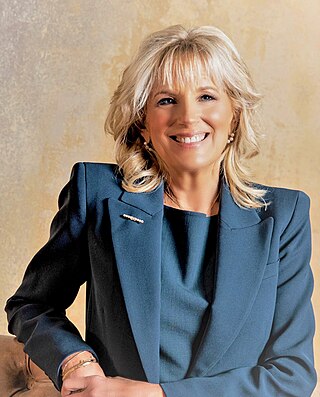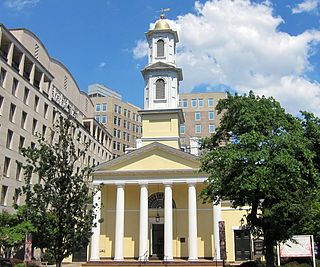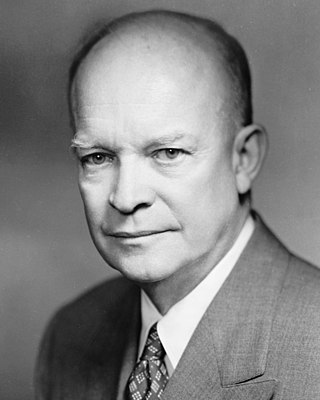
First Lady of the United States (FLOTUS) is the title held by the hostess of the White House, usually the wife of the president of the United States, concurrent with the president's term in office. Although the first lady's role has never been codified or officially defined, she figures prominently in the political and social life of the United States. Since the early 20th century, the first lady has been assisted by official staff, known as the Office of the First Lady and headquartered in the East Wing of the White House.

James Earl Carter Jr. is an American politician and humanitarian who served as the 39th president of the United States from 1977 to 1981. A member of the Democratic Party, Carter was the 76th governor of Georgia from 1971 to 1975, and a Georgia state senator from 1963 to 1967. At age 99, he is both the oldest living former U.S. president and the longest-lived president in U.S. history.

Religious affiliations can affect the electability of the presidents of the United States and shape their stances on policy matters and their visions of society and also how they want to lead it. While no president has ever openly identified as an atheist, Thomas Jefferson, Abraham Lincoln, and William Howard Taft were speculated to be atheists by their opponents during political campaigns; in addition, a survey during the presidency of Donald Trump showed that 63% of Americans did not believe he was religious, despite his professed Christian affiliation. Trump supporters have also circulated conspiracy theories that Barack Obama is a Muslim. Conversely, other presidents, such as Jimmy Carter, have used their faith as a defining aspect of their campaigns and tenure in office.

The Republican Party, also known as the GOP, is one of the two major contemporary political parties in the United States. It emerged as the main political rival of the then-dominant Democratic Party in the mid-1850s, and the two parties have dominated American politics ever since.

William Howard Taft was the 27th president of the United States, serving from 1909 to 1913, and the tenth chief justice of the United States, serving from 1921 to 1930, the only person to have held both offices. Taft was elected president in 1908, the chosen successor of Theodore Roosevelt, but was defeated for reelection in 1912 by Woodrow Wilson after Roosevelt split the Republican vote by running as a third-party candidate. In 1921, President Warren G. Harding appointed Taft to be chief justice, a position he held until a month before his death.

The Executive Office of the President of the United States (EOP) comprises the offices and agencies that support the work of the president at the center of the executive branch of the United States federal government. The office consists of several offices and agencies, such as the White House Office, the National Security Council, Homeland Security Council, Office of Management and Budget, council of Economic Advisers, and others. The Eisenhower Executive Office Building houses most staff.

The Twenty-second Amendment to the United States Constitution limits the number of times a person can be elected to the office of President of the United States to two terms, and sets additional eligibility conditions for presidents who succeed to the unexpired terms of their predecessors. Congress approved the Twenty-second Amendment on March 21, 1947, and submitted it to the state legislatures for ratification. That process was completed on February 27, 1951, when the requisite 36 of the 48 states had ratified the amendment, and its provisions came into force on that date.

William Howard Taft III was an American diplomat who served as United States Ambassador to Ireland from 1953 to 1957, and was a grandson of President William Howard Taft and First Lady Helen Louise "Nellie" Taft.

The ceremonial first pitch is a longstanding ritual of baseball in which a guest of honor throws a ball to mark the end of pregame festivities and the start of the game. Originally, the guest threw a ball from their seat in the grandstand to the pitcher or catcher of the home team, but the ritual changed after United States President Ronald Reagan threw the first pitch on the field at an unscheduled appearance at a Baltimore Orioles game. Now, the guest stands on or in front of the pitcher's mound and throws towards home plate. The ceremonial thrower sometimes stands on the mound. The recipient of the pitch is usually a player from the home team.

The Draft Eisenhower movement was a widespread political movement that eventually persuaded Dwight D. Eisenhower, former Chief of Staff of the United States Army, to contest the presidency of the United States.

Peter Eleftherios Baker is an American journalist and author. He is the chief White House correspondent for The New York Times and a political analyst for MSNBC, and was previously a reporter for The Washington Post for 20 years. Baker has covered five presidencies, from Bill Clinton through Joe Biden.

From March 11 to June 3, 1952, delegates were elected to the 1952 Republican National Convention.
During his time in office, President Warren G. Harding appointed four members of the Supreme Court of the United States: Chief Justice William Howard Taft, and Associate Justices George Sutherland, Pierce Butler, and Edward Terry Sanford.
The Boston mayoral election of 1867 saw the election of Democratic Party nominee Nathaniel B. Shurtleff, who unseated Republican incumbent Otis Norcross.

Donald Trump, the 45th president of the United States, who served from 2017 to 2021, announced his campaign for a nonconsecutive second presidential term in the 2024 U.S. presidential election on November 15, 2022. He was officially nominated on July 15, 2024 at the Republican National Convention in Milwaukee, where he announced J. D. Vance, the junior U.S. Senator from Ohio, as his nominee for vice president and campaign partner.

Recollections of Full Years is a 1914 memoir by Helen Taft, a First Lady of the United States and wife of William Howard Taft. The memoirs were the first to be published by a first lady. The book serves as "the most important source of information" about Helen Taft.
The first 100 days of the Joe Biden presidency began on January 20, 2021, the day Biden was inaugurated as the 46th president of the United States. The first 100 days of a presidential term took on symbolic significance during Franklin D. Roosevelt's first term in office, and the period is considered a benchmark to measure the early success of a president. The 100th day of his presidency ended on April 30.














